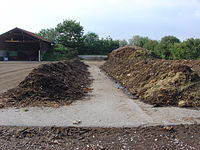
Photo from wikipedia
This study investigated the effects of representative co-substrate (corncob particles) and additive (brick granules) alone on antibiotic resistome of swine manure during composting and subsequent compost application. For relative abundances,… Click to show full abstract
This study investigated the effects of representative co-substrate (corncob particles) and additive (brick granules) alone on antibiotic resistome of swine manure during composting and subsequent compost application. For relative abundances, four antibiotic resistance gene (ARG) types encoding resistance to aminoglycoside, multidrug, florfenicol-chloramphenicol-amphenicol-fluoroquinolone-quinolone, and sulfonamide increased remarkably during composting, whereas all the ARG types decreased after compost application. Interestingly, much more ARG subtypes (50.1% in total) were reduced in corncob addition treatment. Meanwhile, the addition of corncob particles lowered the relative abundance and diversity of ARGs more significantly. Microbial community exhibited conspicuous changes across the manure, compost, and soil samples where the dominant genera were completely different. Procrustes test proved the co-occurrence and driving effect of microbial community on resistome variation, especially in corncob addition treatment during composting. Network analysis demonstrated that the dissipation of the dominant genera such as Ruminofilibacter, Luteimonas, and Pseudidiomarina in the composts after application contributed greatly to the reduction in ARG relative abundance. Besides, the low abundance of mobile genetic elements (MGEs) in soil also accounted for the attenuation of ARGs to some extent. Our findings clearly proved that co-composting materials can further affect the attenuation of antibiotic resistome in soil application, which can help in understanding the spread and control of ARGs during agricultural process.
Journal Title: Waste management
Year Published: 2021
Link to full text (if available)
Share on Social Media: Sign Up to like & get
recommendations!